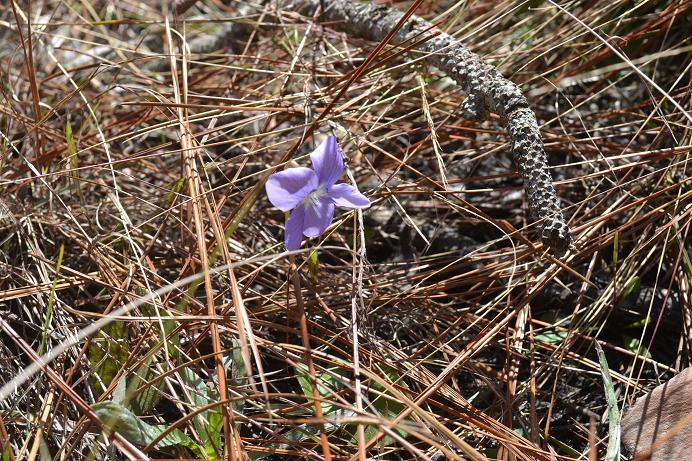Difference between revisions of "Viola palmata"
KatieMccoy (talk | contribs) |
KatieMccoy (talk | contribs) |
||
| Line 39: | Line 39: | ||
===Seed bank and germination=== | ===Seed bank and germination=== | ||
===Fire ecology=== <!--Fire tolerance, fire dependence, adaptive fire responses--> | ===Fire ecology=== <!--Fire tolerance, fire dependence, adaptive fire responses--> | ||
| + | It has been observed flowering February and March after a fire (FSU Herbarium). | ||
| + | |||
===Pollination=== | ===Pollination=== | ||
===Use by animals=== <!--Herbivory, granivory, insect hosting, etc.--> | ===Use by animals=== <!--Herbivory, granivory, insect hosting, etc.--> | ||
Revision as of 13:46, 15 October 2015
| Viola palmata | |
|---|---|

| |
| Photo was taken by Gil Nelson | |
| Scientific classification | |
| Kingdom: | Plantae |
| Division: | Magnoliophyta – Flowering plants |
| Class: | Magnoliopsida – Dicotyledons |
| Order: | Violales |
| Family: | Violaceae |
| Genus: | Viola |
| Species: | V. palmata |
| Binomial name | |
| Viola palmata L. (pro sp.) | |

| |
| Natural range of Viola palmata from USDA NRCS Plants Database. | |
Common name: early blue violet
Contents
Taxonomic notes
Description
Distribution
Ecology
Habitat
In the Coastal Plain in Florida and Georgia, V. palmata has been found in natural longleaf stands; longleaf pine-wiregrass savannas; loamy soil along mesic hardwood slopes; seepages in ravines; river banks; sandy loam under beech-magnolia forests; hardwood hammocks; oak-palmetto woods; alluvial soil of floodplain forests; between road and slash pine/wiregrass flatwoods; recently burned longleaf pine; longleaf pine-palmetto flats; loamy sand of grassy savanna; second growth loblolly pinewoods; sandy soil of turkey oak-longleaf pine flats; calcareous bluffs; upland mixed woodlands; beech-magnolia forests; and loamy humus of shallow depression of shaded limestone rock in hardwood maritime hammock (FSU Herbarium; Kirkman et al. 2004). It has been found to be extremely vulnerable to disturbance (Kirkman et al. 2004), however has been found growing along roadsides, sands of disturbed hillside bogs, lakesides, calcareous banks between earth road and drainage canal, ectone between oak woodland and open powerline corridor, heavily cattle grazed palmetto flatwoods, and powerline transect through a longleaf pine-wiregrass savanna (FSU Herbarium).
Substrate types include loamy soil, loamy sand, sandy loam, peaty sand, alluvial soil, sandy-peaty soil, sandy-clayey soil, limestone and loamy humus (FSU Herbarium). Associated species include Carex crebriflora, Viola floridana, Aristida, Eleocharis, V. villosa, V. lanceolata, Chaptalia, Lycopodium, Sisyrinchium, Calopogon, and Hypericum (FSU Herbarium).
Phenology
It is a summer forb (Kirkman et al 2004). It has been recorded flowering February, March, April, December and fruiting February, March, April, August and September (FSU Herbarium).
Seed dispersal
V. palmata is dispersed myrmecochorously or explosively (Kirkman et al. 2004)
Seed bank and germination
Fire ecology
It has been observed flowering February and March after a fire (FSU Herbarium).
Pollination
Use by animals
Diseases and parasites
Conservation and Management
Cultivation and restoration
Photo Gallery
References and notes
Florida State University Robert K. Godfrey Herbarium database. URL: http://herbarium.bio.fsu.edu. Last accessed: July 2015. Collectors: Loran C. Anderson, K. Craddock Burks, Robert K. Godfrey, S. W. Leonard, Wilson Baker, James R. Burkhalter, Robert Kral, L. B. Trott, J. P. Gillespie, D. B. Ward, J. Beckner, Patricia Elliot, Cecil R Slaughter, S. R. Harrison, C. Jackson, Nir L. Gil, Angus Gholson, Steve L. Orzell, Edwin L. Bridges, A. G. Shuey, Sidney McDaniel, S. C. Hood, Richard Carter, Mark A Garland, Richard S. Mitchell, Karen MacClendon, B. & M. Boothe, M. R. Darst, Rodie White, R. A. Norris, R. Komarek. States and Counties: Florida: Calhoun, Clay, Flagler, Franklin, Gadsden, Hamilton, Holmes, Jackson, Jefferson, Leon, Liberty, Madison, Manatee, Marion, Okaloosa, Santa Rosa, Seminole, St. Johns, Taylor, Wakulla, Washington. Georgia: Thomas. Compiled by Tall Timbers Research Station and Land Conservancy.
Kirkman, L. K., K. L. Coffey, et al. (2004). "Ground cover recovery patterns and life-history traits: implications for restoration obstacles and opportunities in a species-rich savanna." Journal of Ecology 92: 409-421.
